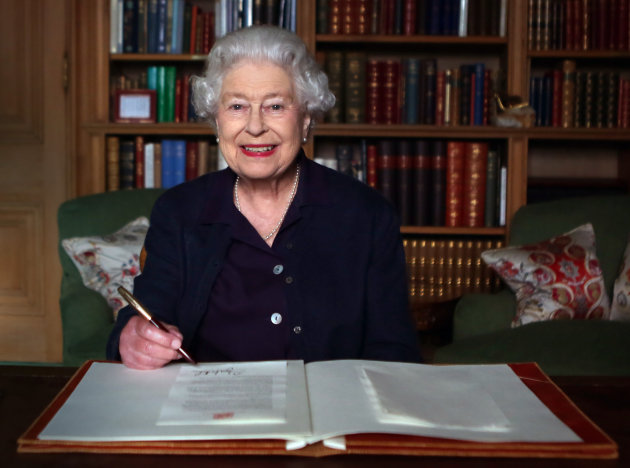
We put the Queen’s finances under the spotlight. Where does she get her money from and what does she spend it on?
Even the Queen is having trouble managing her budget in austerity Britain. Last month it was revealed that Queen Elizabeth II’s rainy day fund was down to its last million.
A report by the Public Accounts Committee revealed the Queen’s advisers were failing to control her finances while the royal palaces were “crumbling”. Both Buckingham Palace and Windsor Castle are reported to be in urgent need of repair with staff routinely catching rain in buckets to protect art and antiques.
As recently as 2001 the Queen’s “reserve fund” was at a healthy £35million but now stands at a paltry £1million. MPs blamed the Royal Family’s advisers for overspending.
Don’t feel too sorry for the Monarch though. Queen Elizabeth II’s rainy day fund may be looking a bit lame but she’s worth a lot more than that – £320million according to the Sunday Times Rich List 2013.
Where does all this money come from?Firstly, there’s property – the Queen has one of the largest property empires in the world.
The Queen’s holdings include Balmoral Castle in the Scottish Highlands, Buckingham Palace, Windsor Castle and Kensington Palace. The Crown Estate, the company that owns and manages the sovereign’s land, also owns large swathes of London’s Regent Street, the Royal Parks, Ascot racecourse and 106,000 hectares of farmland. There are also stud farms, a fruit farm and marine land throughout the UK.
The Crown Estate is managed by an independent organisation on behalf of the Government. From April 2012, 15% of the profit from The Crown Estate goes to the Sovereign Grant (which partly funds the Queen), with the rest going to the Treasury.
Other royal assets include an extensive art and fine jewellery collection, and one of the world’s largest stamp collections built by the Queen’s grandfather
Although estimates of The Queen’s wealth include the royal assets, these are not her private property – she can’t sell them. Instead they are held by her as Sovereign on behalf of the nation and they will eventually be passed on to her successor.
So where does HRH’s spending money come from?The Queen essentially receives an income in three main ways: The Sovereign Grant, the Privy Purse and The Queen’s personal wealth and income.
The Sovereign Grant came into existence in April 2012 and replaced the old way of funding the Royal family through the Civil List and various Government grants. The Sovereign Grant is equal to 15% of the profits from the Crown Estate from two years previously
The Sovereign Grant was worth £31million in the year 2012-13 but the Royal Household’s net expenditure was £33.3million, hence the Queen needing to dip into her reserve fund to make ends meet.
However, Royal finances should be back on track soon. With the Crown Estate booming (it made a profit of £253million last year), the Sovereign Grant is £36.1 million for the tax year 2013-14 and set to rise to £37.9 million in 2014-15.
Out of this cash, the Queen must carry out her official duties, and maintain the “occupied” Royal Palaces: Buckingham Palace, St James’s Palace, Clarence House, Marlborough House Mews, Windsor Castle, the buildings in the Home and Great Parks at Windsor, and Hampton Court Mews and Paddocks.
What’s in the Privy Purse?The next source of income for the Queen is the Privy Purse. This is a historical term used to describe income from the Duchy of Lancaster. It’s used to meet both official and private expenditure by The Queen.
The Duchy of Lancaster is a portfolio of land, property and assets held in trust for the Sovereign. It’s administered separately from the Crown Estates and generally used to meet official expenses incurred by other members of the Royal Family. In the financial year ending 31st March 2013, it was valued at £429 million. However the Queen can’t get her hands on the capital of the portfolio, just revenue profits. This secured her an income of £12.5million in 2012-13.
The Duchy of Cornwall is yet another property portfolio held in trust, this time to meet, in part, the expenses of the monarch's eldest son and various members of his family. Prince Charles receives revenue from it to pay for his official activities, as does Camilla as Duchess of Cornwall, William and Kate (The Duke and Duchess of Cambridge) and Prince Harry.
The estate was valued at £763million last year providing Charles with private income of about £19million.
The Queen’s third source of funding is her personal income. This comes from her personal investment portfolio and private estates. The Queen personally owns the Balmoral and Sandringham Estates, which were both inherited from her father. The Queen’s private income is used to meet her “private expenses”.
So, what does the Queen spend her money on? It’s mostly official duties such as travel for official engagements in the UK and abroad; the maintenance of Royal residencies; funding for the work of The Duke of Edinburgh which supports and complements that of The Queen; and salaries for employees of the Royal Household.
No comments:
Post a Comment